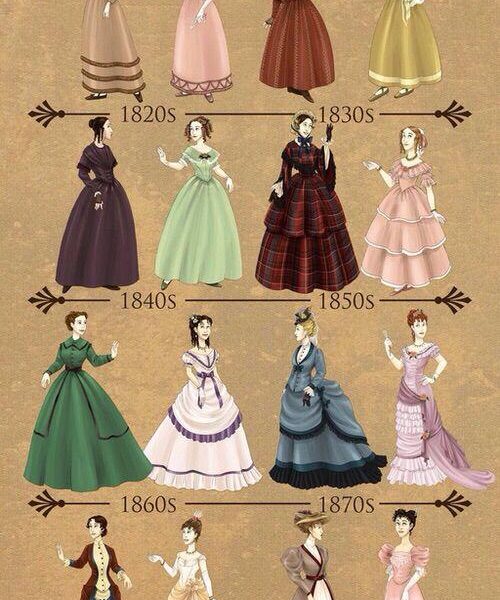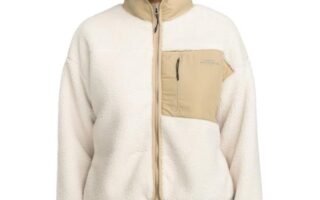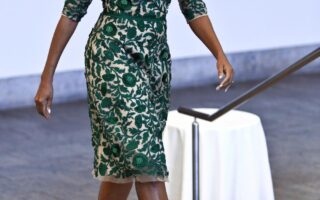The 1800s was a century of transformation, marked by sweeping social, political, and technological change. As these currents of history shaped lifestyles and aspirations, the realm of women’s fashion danced to its own captivating rhythm. From the extravagant silhouettes of the early 19th century, characterized by corsets and voluminous skirts, to the streamlined elegance of the late Victorian period, women’s clothing showcased not only personal taste but also societal roles and expectations. In this exploration of 1800s female attire, we delve into the fabrics, styles, and cultural influences that defined an era, revealing how clothing served as a canvas for expression and a reflection of the evolving identity of women in a rapidly changing world. Join us as we unravel the threads of history woven into the garments that adorned women of the 1800s, illuminating the stories behind the stitches and seams.
Table of Contents
- The Evolution of Female Fashion in the 1800s
- Materials and Textiles: Understanding the Fabric of the Era
- Key Wardrobe Pieces: Essential Attire for Victorian Women
- Dressing for the Occasion: Social Norms and Fashion Choices
- Q&A
- Future Outlook
The Evolution of Female Fashion in the 1800s
The 1800s marked a transformative era in female fashion, reflecting broader social, political, and technological changes. The beginning of the century was largely dominated by the Empire silhouette, characterized by high waistlines just under the bust and flowing fabrics that emphasized a light and ethereal quality. Fabrics like muslin became incredibly popular, and women adorned themselves with lace and ribbons for a delicate touch. As the century progressed, the Victorian influence emerged, bringing with it corsets, fuller skirts supported by crinolines, and an explosion of elaborate decorations. The following popular styles shaped the decade:
- Empire Waist Gowns: Light and flowing, often in pastel colors.
- Crinolines: Structured underskirts that created volume.
- Bustle Dresses: Late-century styles introduced back padding for shape.
- Hats and Bonnets: Essential accessories adorned with ribbons and flowers.
The evolution culminated in the late 1800s with the rise of the art nouveau movement, subtly shifting towards more natural forms in fashion. Influences from the Aesthetic Movement encouraged a rejection of over-ornamentation, leading to simpler lines and a focus on quality fabrics over embellishments. This shift heralded the beginning of a more modern approach to women’s clothing, paving the way for the early 20th century styles that would embrace practicality and comfort. A comparison of key fashion elements from the beginning and end of the century illustrates this transition:
| Era | Silhouette | Fabric Choices | Key Features |
|---|---|---|---|
| Early 1800s | Empire Line | Muslin, Silk | High waists, flowing designs |
| Late 1800s | Bustle | Wool, Satin | Structured shapes, layers |
Materials and Textiles: Understanding the Fabric of the Era
The 1800s bore witness to a fascinating evolution in women’s clothing, driven by technological advancements and shifts in societal norms. As the Industrial Revolution took hold, the introduction of mechanized textile production not only increased the availability of fabrics but also diversified the types of materials used. Women adorned themselves in cotton, wool, and sensations such as silk, which allowed for garments ranging from everyday wear to extravagant evening dresses. The period’s fashion was marked by a preference for diverse textures, with intricate embellishments like lace and embroidery that highlighted craftsmanship.
Key styles emerged throughout the century, characterized by various cuts and silhouettes that reflected both taste and practicality. Corsets became a staple, emphasizing an hourglass figure, while skirts evolved into voluminous forms with petticoats and crinolines. The use of color also transformed; vibrant prints and pastel shades became popular in the mid-century. Below is a simplified table showcasing some of the predominant fabrics and their characteristics during this time:
| Fabric | Characteristics |
|---|---|
| Cotton | Lightweight, breathable, versatile |
| Wool | Durable, insulating, commonly used for winter wear |
| Silk | Luxurious, smooth, used for formal occasions |
| Linen | Cooling, crisp, ideal for summer garments |
Key Wardrobe Pieces: Essential Attire for Victorian Women
The Victorian era was characterized by its distinctive fashion, with women’s wardrobes reflecting societal status, propriety, and adherence to cultural norms. Essential attire for Victorian women included a variety of key pieces that not only exhibited elegance but also adhered to the intricacies of social etiquette. Prominent among these were bustle skirts, which enhanced the silhouette, and corsets, designed to create an hourglass figure while supporting modesty. Women often paired these with blouses adorned with lace and ruffles, adding an element of femininity and sophistication to their outfit.
In addition to skirts and tops, accessories played a vital role in showcasing one’s fashion acumen. Shawls made from rich fabrics served as both warmth and decoration, while gloves were mandatory for almost any occasion, signifying class and decorum. The allure of hats cannot be overlooked, as they were often lavishly designed with feathers, ribbons, and flowers, completing a Victorian woman’s ensemble. Below is a table summarizing these essential components:
| Wardrobe Piece | Function |
|---|---|
| Bustle Skirt | Enhances silhouette |
| Corset | Creates hourglass figure |
| Blouse | Feminine elegance |
| Shawl | Warmth and decoration |
| Gloves | Signifies class |
| Hat | Completes ensemble |
Dressing for the Occasion: Social Norms and Fashion Choices
In the 1800s, women’s fashion was a reflection of societal expectations and social norms, often dictating how one presented themselves in various settings. Clothing choices were not merely for comfort; they were instrumental in conveying status, respectability, and adherence to the cultural standards of the time. The silhouette of the period evolved dramatically, showcasing a fascinating interplay between femininity and formality. The Empire waist dresses, characterized by their high waistline and flowing skirts, became synonymous with elegance. Furthermore, fabrics such as silk, muslin, and brocade were frequently chosen for their luxurious qualities, often featuring intricate patterns and embellishments. Selecting the perfect ensemble meant understanding whether one was attending a formal ball, a casual gathering, or a social call, with each occasion requiring a specific type of attire.
Accessories played a pivotal role in enhancing a woman’s outfit and signaling her social standing. Belts, shawls, and bonnets were carefully selected to complement the primary garment, creating a polished appearance that adhered to societal conventions. Consider the table below, which outlines common accessories worn by women in the 1800s and their significance:
| Accessory | Purpose |
|---|---|
| Bonnets | To protect the hair and face from the sun while exhibiting sophistication. |
| Shawls | To provide warmth and elegance, often made from fine materials. |
| Gloves | To maintain cleanliness and convey refinement, especially during formal events. |
| Fans | Used for both cooling and communicating subtle social messages. |
Q&A
Q&A: Exploring 1800s Female Fashion
Q: What characterized female fashion in the 1800s?
A: Female fashion in the 1800s was marked by distinct silhouettes, brilliant fabrics, and elaborate accessories that varied through the decades. Early in the century, women favored high-waisted dresses with empire waistlines, flowing skirts, and light fabrics. By the mid-century, the crinoline era took hold, introducing voluminous skirts supported by petticoats or crinolines. Toward the end of the century, styles shifted toward more structured forms, with tailored bodices and longer skirts adorned with lace and trims.
Q: How did socio-political events influence women’s clothing during this time?
A: At the dawn of the century, the French Revolution spurred a shift toward simpler garments as a reaction against the extravagance of the aristocracy. This trend continued with the rise of the Romantic Movement, which emphasized individuality and natural beauty. The women’s rights movement also influenced fashion as women began to seek more practical and comfortable clothing, gradually steering trends toward functionality alongside femininity.
Q: What materials were commonly used in 1800s women’s clothing?
A: Fabrics varied widely depending on social class and occasion. Wealthier women often wore silk, satin, and velvet, while common women typically opted for cotton and wool. Printed calico was especially popular for everyday wear. The invention of the sewing machine later in the century also allowed for the production of a variety of trims, such as lace and ribbons, enhancing the embellishments available for garments.
Q: Can you describe the accessories that were popular in the 1800s?
A: Accessories played a crucial role in completing a woman’s outfit during the 1800s. Bonnet styles evolved throughout the years, with lavish decorations like ribbons and flowers. Gloves, often made of kid leather or cotton, were essential for modesty and elegance. Shawls and capes were common for warmth and style, while brooches, necklaces, and parasols added a personal touch to attire.
Q: How did the century impact the practicality of women’s clothing?
A: As the century progressed, there was a growing recognition of the need for practicality in women’s clothing. The introduction of bloomers in the mid-to-late 1800s signified a desire for more comfortable and less restrictive clothing. This was a significant shift, signaling the beginning of a movement toward more practical daywear, especially as women began participating more actively in social and public spheres.
Q: Were there any notable fashion icons or trends setters of the time?
A: Indeed! Figures like Queen Victoria greatly influenced fashion in the 19th century. Her preference for modest yet elegant styles, alongside the heavy fabrics and mourning attire after the death of her husband, Albert, set trends across Europe. Additionally, actresses and socialites often set trends that spread through fashion magazines of the time, such as “Godey’s Lady’s Book,” which showcased the latest styles and patterns.
Q: How can we draw parallels between 1800s fashion and contemporary styles?
A: Though separated by more than a century, certain aspects of 1800s fashion can be seen in modern trends. The continued appreciation for vintage aesthetics is evident today, with elements like high-waisted skirts and sophisticated blouses making a comeback. Furthermore, the modern focus on sustainable clothing can echo the practicality demanded by women in the 1800s who sought functionality alongside style, emphasizing a cyclical nature of fashion.
Q: What is the takeaway regarding 1800s women’s clothing?
A: The clothing of the 1800s not only reflects the aesthetic values of the time but also narrates the evolving status and roles of women in society. These styles serve as a reminder of the historical context of fashion—an interplay between personal expression, social norms, and political movements that continues to shape how we view clothing today.
Future Outlook
As we draw the curtains on our exploration of 1800s women’s clothing, we are left with a vivid tapestry woven from the threads of history, culture, and individuality. The garments of this era were not merely fabrics stitched together; they embodied the spirit and aspirations of women navigating the complexities of a rapidly changing world. From the intricate embroidery of a Victorian gown to the practical simplicity of a pioneer woman’s dress, each piece tells a story of resilience, beauty, and the relentless pursuit of identity.
As we reflect on the elegance and function of 19th-century attire, we gain insight into the societal roles and expectations that shaped women’s lives. These historical garments serve as a reminder of the progress women have made and the legacies they uphold today. Whether you’re an avid fashion historian, a curious mind, or simply captivated by the artistry of clothing, the fashion of the 1800s invites us to look back with admiration and forward with inspiration. The echoes of their choices resonate in modern fashions, reminding us that clothing, in all its forms, is a powerful medium of self-expression and cultural conversation.



